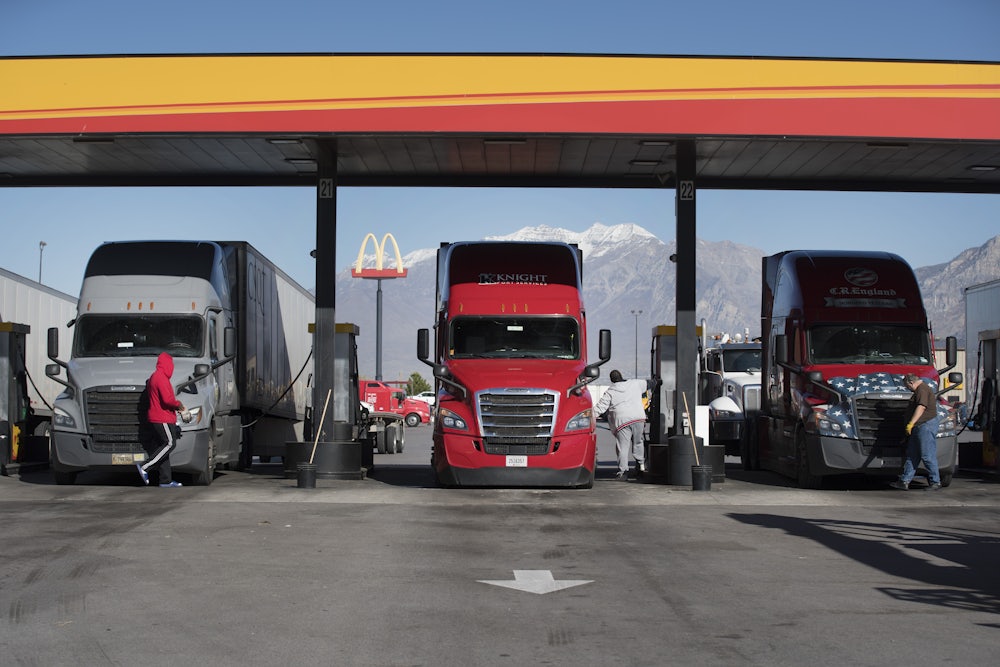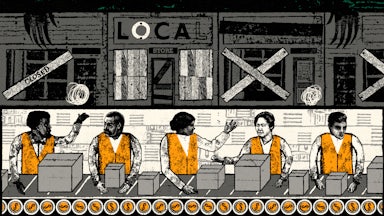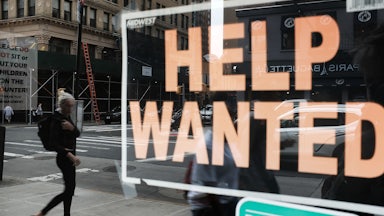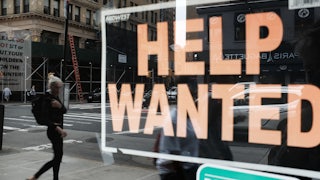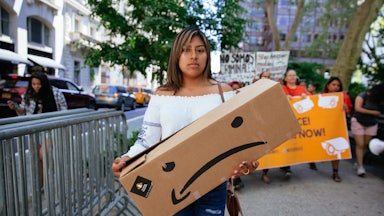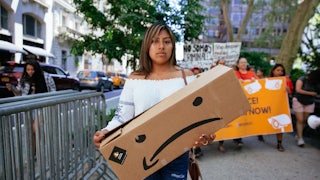The media is once again commemorating Black Friday by
running stories intended to answer any question that might be Googled by
someone who is ready to shop. The Washington Post can tell you what time
stores will be open and where to snag
the best deals. A New Hampshire
outlet took
strategy tips from a woman who will wear a “Black Friday Queen” t-shirt
while she shops until she “cannot see.” As of Monday, The New York Times had
already begun counting down to an upcoming sale on the Nintendo Switch
(although the union for the Times’ dedicated consumerism writers at The
Wirecutter chose this weekend for a strike). It would all feel quite
routine if it weren’t for the looming sense that Covid-19 has
conspired to ruin the long-standing American tradition of collectively mobbing
the mall.
In the months leading up to this dedicated shopping season, experts have warned of ongoing supply chain disruptions that could ruin the holidays—or at least make packages arrive late. The Economist detailed the emerging “shortage economy” that could impact global growth; The Wall Street Journal said there aren’t enough truckers to deliver packages (which is only partially true, but more on that below). The crisis has been forecast for some time: Back in July, the White House noted that businesses weren’t able to hire enough workers and were also running out of things to sell. As far as winter shopping goes, consumers are told to expect less of a selection for a significantly higher price.
There are myriad reasons for various shortages. Wealthy Americans did shop a lot during the pandemic, with one click delivering them a monstrous amount of stuff. And early in the plague, factory capacities were lost when countries like China, besieged by the virus, shut down. But even in those cases, large companies found glaringly dystopic workarounds for a mass-casualty event: As Rest of World reported recently, the crisis inspired Vietnamese factory owners to ask workers to sleep next to the assembly line so as to keep building Samsung products without breaking quarantine.
But the
pandemic exacerbated issues that have been roiling on for some time. The
problem stems in part from the fact that, since the 1970s, product components
have been outsourced
and subcontracted until several different companies might be creating each
piece of any given gadget for the lowest price. And like the worker shortages that have beset the medical
and service
industries, there are endemic reasons why it’s getting harder for Americans to find whatever they
want as soon as they’re hit by the desire: At a number of crucial links in the
supply chain, it seems the systematic dismantling of entire workforces has
contributed to the problem quite a bit.
If stores that might have previously catered to Thanksgiving-eve shoppers who arrive at the mall as soon as they clear their plates of turkey aren’t able to keep the same hours, it might be because the retail associates they rely on have walked off the job. They may have done so because they were sick of years working 15-hour shifts under extreme duress for minimum wage, without overtime or paid time off, even before the threat of a pandemic. The warehouse workers who package goods at Amazon, dodging dangerous robots, are said to be “endangering” the company’s quick turnaround times—a problem created by Amazon itself when it built its model on churning through workers but didn’t consider what would happen if it ran out of new bodies to throw into its grinding machine.
When it comes to the workforce that moves those sundries from ports to warehouses, despite reports of a “truck driver shortage,” there are actually plenty of licensed drivers around. But the industry has a massive retention problem because the companies that train and employ them, according to a recent story in Time, routinely misrepresent how much those workers could make. By the end of 2020, per the American Trucking Institute, nine out of 10 drivers working for large companies left within the space of a year; as Time reported, some of those drivers made less than $3 a mile to do a famously dangerous job. Many take on massive debt to get licensed to drive at all, debt that they’re unlikely to pay back with wages so low: A USA Today investigation from 2017 reported one man’s take-home pay amounted to 67 cents in a week. And squeezing drivers has been a long-term project: Since the 1980s, according to E. Tammy Kim, the network that connects ports and railyards transformed from a labor pool of employees to a group of independent contractors. Wage workers became owner-operators paid between $50 and $100 a load, and sometimes not at all for the time they spend working but not actively moving cargo.
Recently the president of the International Chamber of Shipping, a trade organization representing a majority of large international ship owners, published an op-ed in The New York Times arguing that the “workers who drive the trucks, fly the planes, and crew the ships” that move goods across the globe have been “stretched to the breaking point.” He described crews stuck at sea, unable to disembark when they arrived at a foreign port, and a lack of cohesive plans for workers who were unable to get vaccinated in their home countries. Elsewhere, labor advocates have noted that as many as 40,000 members of the shipping workforce have been unable either to leave their vessels or return home because of travel bans across the world. Many have been stuck in limbo, working far past their contracts. One German ship captain refused to sail until his crew was replaced by another group of people who hadn’t been so desperately overextended; it was an issue of safety, he said.
As with other aspects of economy and society, the pandemic exacerbated dire scenarios that were barely sustainable before Covid-19 took hold. The holiday season has always been a nightmare for the massive class of people who facilitate Americans’ relentless quest for a killer sale. Every year, retail workers tell horror stories about the Black Fridays they staffed for less than $15 an hour. Jessica Bruder reported in 2014 on the mostly elderly migrant labor force that camped out near warehouses to shelve freight for $12.25 an hour during the pre-December rush. Last year, Reveal obtained Amazon documents that showed warehouse injuries spiked right around Prime Day and Cyber Monday, holidays the tech giants created because Black Friday wasn’t enough for them.
Indeed, the sales-and-specials competition and the pressure it puts on workers is no longer limited to certain days. When Target announced it would keep stores permanently closed on Thanksgiving, spinning it as a kind of community-minded gesture, the Associated Press noted that it’s worked out very well for retailers to expand “a weekend shopping blitz into an extended event, with big holiday discounts beginning as early as October.”
Black Friday may have turned from a day into a season, but the distribution of big sales hasn’t made conditions for workers any less grim. Meanwhile, the big box stores and e-commerce sites, having seen record profits through most of the pandemic, are planning on slightly raising wages in order to hire. They intend to pass the cost directly to consumers this year, which makes this all feel like a temporary and extraordinary event. But the conditions that led to these supply chain issues have been decades in the making, and the labor practices they’ve exposed aren’t going away any time soon.
